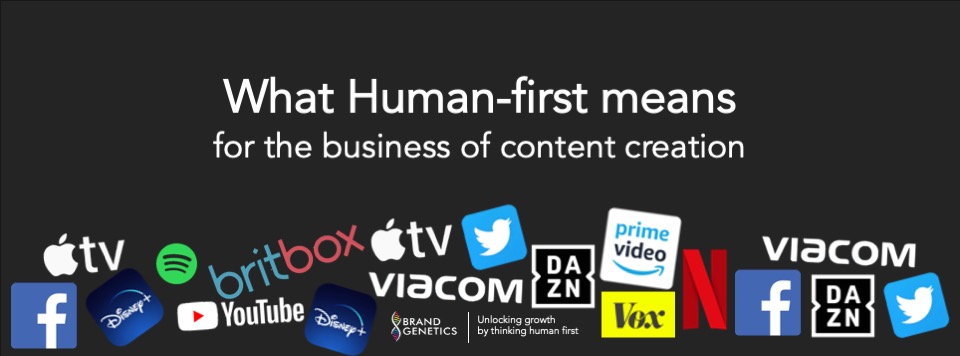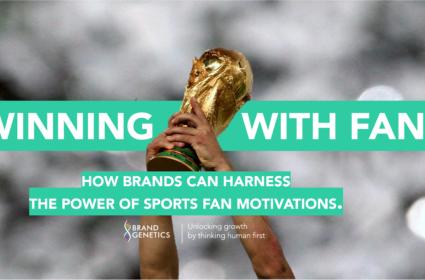What Human-first means for the business of content creation

The business of content was already a hot 2020 topic way before you mention the recent global events that have forced us into our homes and using streaming services more than ever.
- Disney bought Fox for an astounding $71 billion, intensifying an already frenzied “streaming war” between Netflix, Amazon, Disney and the rest
- DAZN has continued to disrupt the sports broadcasting market and this year announced plans to expand into 200 countries worldwide
- Joe Rogan signed an exclusive multi-year podcast deal at Spotify believed to be worth $100m (£82m) – this is incredible, with figures involved rare in the podcast world, with Rogan now likely earning more money than most musicians on Spotify
- And as the global pandemic intensified streaming platforms across the board have seen a surge in usage, from Netflix and Disney, to game streaming platforms like Twitch, which has seen a 31% growth in viewership
Whilst streaming – and the content created for a multitude of services – is nothing new, 2020 is proving to be a year of seismic changes across the industry, putting the spotlight on streaming and content like never before.
The story for streaming is a generally positive one, given its continued growth and dominance, but it’s not without its challenges:
Firstly, with the new growth has come a new set of users. The global lockdown has forced a change in behaviour for many people, and new and broader audiences have been exposed to an industry and brands they didn’t know before. The industry is faced with adapting to the needs and demands of these new audiences
Secondly, new occasions – the where, when and how long – is adapting in the new context. Some behaviours remain unchanged but music, for example, has experienced a fall in streaming content, as its marketing vehicles – concerts – are no longer able to promote the industry as a whole
Third new needs. Connected to this is the ‘what’ we are able to consume. Whilst many are investing in content, including improved hardware at home to make the most out of time spent there we are now starting to experience the challenges of what we can watch. Live sports have still largely stopped. Filming of many shows have been put on pause (apart from entrepreneurial content creators like Ayanda Makayi, the brainchild behind Lockdown Heights). It only takes one viewing of an audience-less WWE to understand how severe these changes can be!
On the flip, the scope of streaming platforms has expanded with more movies launching straight on to Amazon Prime – for example, Gulabo Sitabo is one of the first big-ticket blockbuster Bollywood films to launch online instead of cinemas.
Why are we watching – what mood are we trying to create, what desire are we trying to fulfil is shifting and brands must keep up to avoid viewer fatigue (after all how many are plagued by Zoom fatigue by now). Consumers are in a very different headspace at this point in time and the tone of content is having to adapt to reflect this.
At Brand Genetics we think human-first. Using human science and empathy to understand people from the core and help organisations step into consumers shoes. By focusing on real human problems and satisfying universal human needs we can make better decisions and unlock positive innovation that improves peoples’ lives and drives organisational growth. We do this in three key ways:
1. Utilise human science to focus on what’s stable versus what’s changing. To attract new and old users.
We often see moments of instability as moments of opportunity. Whilst true these moments often also highlight the things that don’t change – the things that remain stable that you can build long term business success around
Trends shift and fads change faster, particularly in the world of content when a show can be hot property for a series and then… By comparison our core needs have remained constant for more than just a few centuries. Tapping into universal human truths and motivations can deliver insight for innovation that surpasses immediate short-term behaviour changes. At Brand Genetics we employ behavioural science and psychological principles to help us understand immutable human characteristics and how they manifest
For example, a key psychological model – the ARC of happiness – helps us understand what is and will drive people’s actions and behaviours:
- Autonomy – The desire to be in control of our own life and find the freedom to act in harmony with one’s integrated self. Does your platform deliver on a truly autonomous experience?
- Relatedness – The need to interact, be connected to, and experience caring for others. How does your content drive relatedness?
- Competence – The desire to experience the satisfaction of ‘mastery’ – taking on new challenges and proving yourself successful. Can your UX instil a higher degree of competence?
2. ‘Moving beyond the user to think ‘human first’ to see the bigger picture’ and uncover new occasions
As we look to understand existing and new audiences we often focus on the audience in a microcosm context and about the problems in industry-specific terms (or worse, jargon); “user experience”, “user interface”, “user satisfaction”. This can lead to us forgetting about the human behind this, which limits our insight
Utilizing tools such as empathy mapping, which focuses not just on the actions at each stage of the consumer journey but people’s expectations and emotional response, can help brands explore the context around the digital experience giving a fuller picture of pain and pleasure points. Looking beyond the time they spend directly in contact with content or the platform, why are they choosing to consume at all? What has motivated them to plug in then and what expectations do they have to satisfy or exceed? Knowing not just what your customer does (or doesn’t do) but why they do it to uncover new opportunities
3. Getting closer to your consumer to feel the experience the way they do and truly understand needs
Getting your whole team, from intern to CEO, whether their role is customer facing or not to step into consumers shoes and build their ‘empathic intelligence’ enables better, more meaningful solutions. This is a skill that can be trained for all and benefits the business
Techniques which build empathy are often more immersive, looking at your consumers broader life. Have you spent the day sat on the sofa with your viewers? On the bus with your listeners? At the cinema with your super fans? Engaging your team in experiences (e.g. shop-a-longs or consumer closeness exercises) ensures how you think and innovate on your product remains grounded in reality, and helps understand the role in plays in consumers wider life
Our final ‘so what’
Thinking human-first – embracing behavioural science and empathy will facilitate a shift towards proactive positive innovation rather than reactive trend innovation. From our experience, sustainable and prolonged growth lies with the former.
If you want to find out more about how Brand Genetics can help you think human-first, get in touch today.




